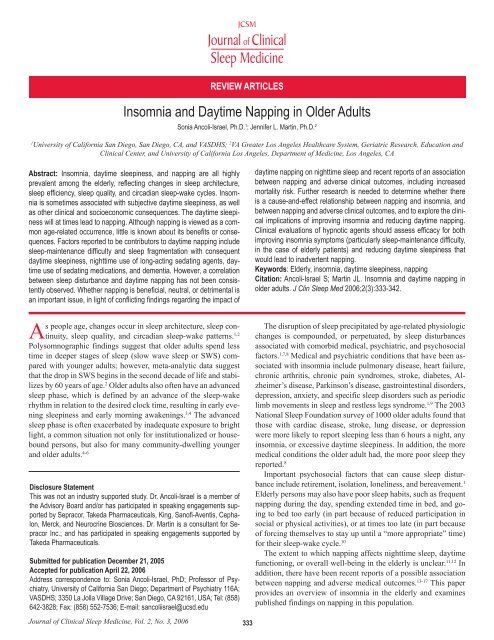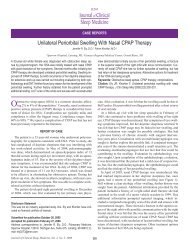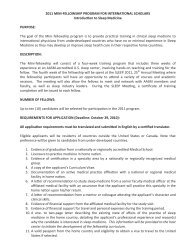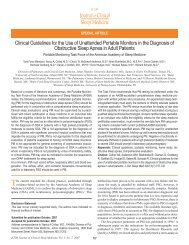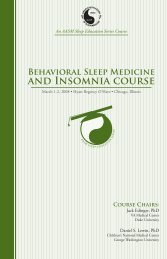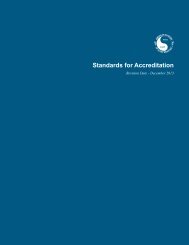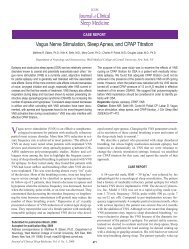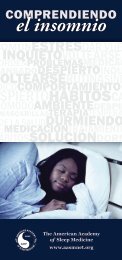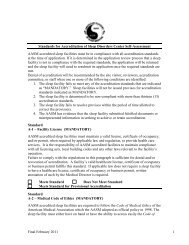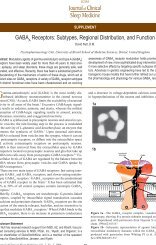Insomnia and Daytime Napping in Older Adults - ResearchGate
Insomnia and Daytime Napping in Older Adults - ResearchGate
Insomnia and Daytime Napping in Older Adults - ResearchGate
You also want an ePaper? Increase the reach of your titles
YUMPU automatically turns print PDFs into web optimized ePapers that Google loves.
REVIEW ARTICLES<br />
<strong>Insomnia</strong> <strong>and</strong> <strong>Daytime</strong> <strong>Napp<strong>in</strong>g</strong> <strong>in</strong> <strong>Older</strong> <strong>Adults</strong><br />
Sonia Ancoli-Israel, Ph.D. 1 ; Jennifer L. Mart<strong>in</strong>, Ph.D. 2<br />
1<br />
University of California San Diego, San Diego, CA, <strong>and</strong> VASDHS; 2 VA Greater Los Angeles Healthcare System, Geriatric Research, Education <strong>and</strong><br />
Cl<strong>in</strong>ical Center, <strong>and</strong> University of California Los Angeles, Department of Medic<strong>in</strong>e, Los Angeles, CA<br />
Abstract: <strong>Insomnia</strong>, daytime sleep<strong>in</strong>ess, <strong>and</strong> napp<strong>in</strong>g are all highly<br />
prevalent among the elderly, reflect<strong>in</strong>g changes <strong>in</strong> sleep architecture,<br />
sleep efficiency, sleep quality, <strong>and</strong> circadian sleep-wake cycles. <strong>Insomnia</strong><br />
is sometimes associated with subjective daytime sleep<strong>in</strong>ess, as well<br />
as other cl<strong>in</strong>ical <strong>and</strong> socioeconomic consequences. The daytime sleep<strong>in</strong>ess<br />
will at times lead to napp<strong>in</strong>g. Although napp<strong>in</strong>g is viewed as a common<br />
age-related occurrence, little is known about its benefits or consequences.<br />
Factors reported to be contributors to daytime napp<strong>in</strong>g <strong>in</strong>clude<br />
sleep-ma<strong>in</strong>tenance difficulty <strong>and</strong> sleep fragmentation with consequent<br />
daytime sleep<strong>in</strong>ess, nighttime use of long-act<strong>in</strong>g sedat<strong>in</strong>g agents, daytime<br />
use of sedat<strong>in</strong>g medications, <strong>and</strong> dementia. However, a correlation<br />
between sleep disturbance <strong>and</strong> daytime napp<strong>in</strong>g has not been consistently<br />
observed. Whether napp<strong>in</strong>g is beneficial, neutral, or detrimental is<br />
an important issue, <strong>in</strong> light of conflict<strong>in</strong>g f<strong>in</strong>d<strong>in</strong>gs regard<strong>in</strong>g the impact of<br />
As people age, changes occur <strong>in</strong> sleep architecture, sleep cont<strong>in</strong>uity,<br />
sleep quality, <strong>and</strong> circadian sleep-wake patterns. 1,2<br />
Polysomnographic f<strong>in</strong>d<strong>in</strong>gs suggest that older adults spend less<br />
time <strong>in</strong> deeper stages of sleep (slow wave sleep or SWS) compared<br />
with younger adults; however, meta-analytic data suggest<br />
that the drop <strong>in</strong> SWS beg<strong>in</strong>s <strong>in</strong> the second decade of life <strong>and</strong> stabilizes<br />
by 60 years of age. 2 <strong>Older</strong> adults also often have an advanced<br />
sleep phase, which is def<strong>in</strong>ed by an advance of the sleep-wake<br />
rhythm <strong>in</strong> relation to the desired clock time, result<strong>in</strong>g <strong>in</strong> early even<strong>in</strong>g<br />
sleep<strong>in</strong>ess <strong>and</strong> early morn<strong>in</strong>g awaken<strong>in</strong>gs. 3,4 The advanced<br />
sleep phase is often exacerbated by <strong>in</strong>adequate exposure to bright<br />
light, a common situation not only for <strong>in</strong>stitutionalized or housebound<br />
persons, but also for many community-dwell<strong>in</strong>g younger<br />
<strong>and</strong> older adults. 4-6<br />
Disclosure Statement<br />
This was not an <strong>in</strong>dustry supported study. Dr. Ancoli-Israel is a member of<br />
the Advisory Board <strong>and</strong>/or has participated <strong>in</strong> speak<strong>in</strong>g engagements supported<br />
by Sepracor, Takeda Pharmaceuticals, K<strong>in</strong>g, Sanofi-Aventis, Cephalon,<br />
Merck, <strong>and</strong> Neurocr<strong>in</strong>e Biosciences. Dr. Mart<strong>in</strong> is a consultant for Sepracor<br />
Inc.; <strong>and</strong> has participated <strong>in</strong> speak<strong>in</strong>g engagements supported by<br />
Takeda Pharmaceuticals.<br />
Submitted for publication December 21, 2005<br />
Accepted for publication April 22, 2006<br />
Address correspondence to: Sonia Ancoli-Israel, PhD; Professor of Psychiatry,<br />
University of California San Diego; Department of Psychiatry 116A;<br />
VASDHS; 3350 La Jolla Village Drive; San Diego, CA 92161, USA; Tel: (858)<br />
642-3828; Fax: (858) 552-7536; E-mail: sancoliisrael@ucsd.edu<br />
daytime napp<strong>in</strong>g on nighttime sleep <strong>and</strong> recent reports of an association<br />
between napp<strong>in</strong>g <strong>and</strong> adverse cl<strong>in</strong>ical outcomes, <strong>in</strong>clud<strong>in</strong>g <strong>in</strong>creased<br />
mortality risk. Further research is needed to determ<strong>in</strong>e whether there<br />
is a cause-<strong>and</strong>-effect relationship between napp<strong>in</strong>g <strong>and</strong> <strong>in</strong>somnia, <strong>and</strong><br />
between napp<strong>in</strong>g <strong>and</strong> adverse cl<strong>in</strong>ical outcomes, <strong>and</strong> to explore the cl<strong>in</strong>ical<br />
implications of improv<strong>in</strong>g <strong>in</strong>somnia <strong>and</strong> reduc<strong>in</strong>g daytime napp<strong>in</strong>g.<br />
Cl<strong>in</strong>ical evaluations of hypnotic agents should assess efficacy for both<br />
improv<strong>in</strong>g <strong>in</strong>somnia symptoms (particularly sleep-ma<strong>in</strong>tenance difficulty,<br />
<strong>in</strong> the case of elderly patients) <strong>and</strong> reduc<strong>in</strong>g daytime sleep<strong>in</strong>ess that<br />
would lead to <strong>in</strong>advertent napp<strong>in</strong>g.<br />
Keywords: Elderly, <strong>in</strong>somnia, daytime sleep<strong>in</strong>ess, napp<strong>in</strong>g<br />
Citation: Ancoli-Israel S; Mart<strong>in</strong> JL. <strong>Insomnia</strong> <strong>and</strong> daytime napp<strong>in</strong>g <strong>in</strong><br />
older adults. J Cl<strong>in</strong> Sleep Med 2006;2(3):333-342.<br />
The disruption of sleep precipitated by age-related physiologic<br />
changes is compounded, or perpetuated, by sleep disturbances<br />
associated with comorbid medical, psychiatric, <strong>and</strong> psychosocial<br />
factors. 1,7,8 Medical <strong>and</strong> psychiatric conditions that have been associated<br />
with <strong>in</strong>somnia <strong>in</strong>clude pulmonary disease, heart failure,<br />
chronic arthritis, chronic pa<strong>in</strong> syndromes, stroke, diabetes, Alzheimer’s<br />
disease, Park<strong>in</strong>son’s disease, gastro<strong>in</strong>test<strong>in</strong>al disorders,<br />
depression, anxiety, <strong>and</strong> specific sleep disorders such as periodic<br />
limb movements <strong>in</strong> sleep <strong>and</strong> restless legs syndrome. 1,9 The 2003<br />
National Sleep Foundation survey of 1000 older adults found that<br />
those with cardiac disease, stroke, lung disease, or depression<br />
were more likely to report sleep<strong>in</strong>g less than 6 hours a night, any<br />
<strong>in</strong>somnia, or excessive daytime sleep<strong>in</strong>ess. In addition, the more<br />
medical conditions the older adult had, the more poor sleep they<br />
reported. 8<br />
Important psychosocial factors that can cause sleep disturbance<br />
<strong>in</strong>clude retirement, isolation, lonel<strong>in</strong>ess, <strong>and</strong> bereavement. 1<br />
Elderly persons may also have poor sleep habits, such as frequent<br />
napp<strong>in</strong>g dur<strong>in</strong>g the day, spend<strong>in</strong>g extended time <strong>in</strong> bed, <strong>and</strong> go<strong>in</strong>g<br />
to bed too early (<strong>in</strong> part because of reduced participation <strong>in</strong><br />
social or physical activities), or at times too late (<strong>in</strong> part because<br />
of forc<strong>in</strong>g themselves to stay up until a “more appropriate” time)<br />
for their sleep-wake cycle. 10<br />
The extent to which napp<strong>in</strong>g affects nighttime sleep, daytime<br />
function<strong>in</strong>g, or overall well-be<strong>in</strong>g <strong>in</strong> the elderly is unclear. 11,12 In<br />
addition, there have been recent reports of a possible association<br />
between napp<strong>in</strong>g <strong>and</strong> adverse medical outcomes. 13-17 This paper<br />
provides an overview of <strong>in</strong>somnia <strong>in</strong> the elderly <strong>and</strong> exam<strong>in</strong>es<br />
published f<strong>in</strong>d<strong>in</strong>gs on napp<strong>in</strong>g <strong>in</strong> this population.<br />
Journal of Cl<strong>in</strong>ical Sleep Medic<strong>in</strong>e, Vol. 2, No. 3, 2006 333
S Ancoli-Israel <strong>and</strong> JL Mart<strong>in</strong><br />
<strong>Insomnia</strong> <strong>in</strong> the Elderly<br />
PREVALENCE<br />
The prevalence of chronic <strong>in</strong>somnia <strong>in</strong>creases with age. The<br />
1991 National Sleep Foundation survey of 1000 US residents aged<br />
18 years <strong>and</strong> older found the prevalence of chronic <strong>in</strong>somnia <strong>in</strong> the<br />
elderly cohort (age ≥ 65 years) to be 20%, compared with 9% <strong>in</strong><br />
the total survey sample. 18 Although older adults were <strong>in</strong>cluded <strong>in</strong><br />
this survey, they made up a small proportion of respondents, <strong>and</strong><br />
therefore these results may not be very generalizable to all older<br />
adults. However, surveys that focused on the elderly have also<br />
been conducted. Almost a decade earlier, <strong>in</strong> 1982, the National<br />
Institute of Ag<strong>in</strong>g conducted the 3-center Established Populations<br />
for Epidemiologic Studies of the Elderly study to determ<strong>in</strong>e the<br />
prevalence of sleep compla<strong>in</strong>ts among 9828 community-dwell<strong>in</strong>g<br />
elderly persons aged 65 <strong>and</strong> older. 19 Fifty-seven percent of<br />
the participants reported at least 1 chronic sleep compla<strong>in</strong>t, <strong>and</strong><br />
29% reported hav<strong>in</strong>g <strong>in</strong>somnia. In each age cohort, the prevalence<br />
of <strong>in</strong>somnia was significantly higher among women than among<br />
men (25% vs 20%, 31% vs 21%, <strong>and</strong> 36% vs 29%, respectively;<br />
p < .05 for each sex difference). Analysis of 3-year follow-up data<br />
from more than 6800 persons aged 65 years <strong>and</strong> older who were<br />
assessed dur<strong>in</strong>g Established Populations for Epidemiologic Studies<br />
of the Elderly found the annual <strong>in</strong>cidence of chronic <strong>in</strong>somnia<br />
to be approximately 5%. 9 More recently, the 2003 National Sleep<br />
Foundation survey of 1000 older adults found that 47% reported<br />
hav<strong>in</strong>g symptoms of <strong>in</strong>somnia (difficulty fall<strong>in</strong>g asleep, wak<strong>in</strong>g<br />
a lot dur<strong>in</strong>g the night, wak<strong>in</strong>g too early <strong>and</strong> not be<strong>in</strong>g able to get<br />
back to sleep, <strong>and</strong> wak<strong>in</strong>g up feel<strong>in</strong>g unrefreshed) at least a few<br />
nights a week. 8,20 A complete review of epidemiologic studies of<br />
sleep <strong>in</strong> older adults can be found <strong>in</strong> Ohayon. 21<br />
IMPACT OF INSOMNIA AND DAYTIME SLEEPINESS<br />
Although 1 study has suggested that self-reported sleep<strong>in</strong>ess <strong>in</strong><br />
people with <strong>in</strong>somnia does not correlate with sleep<strong>in</strong>ess on objective<br />
measures (i.e., the Multiple Sleep Latency Test) <strong>in</strong> adults, 22<br />
reports of <strong>in</strong>somnia have at other times been associated with <strong>in</strong>creased<br />
compla<strong>in</strong>ts of daytime sleep<strong>in</strong>ess 23,24 <strong>and</strong> resultant un<strong>in</strong>tentional<br />
<strong>and</strong> <strong>in</strong>tentional naps. 23 In response to questions posed to<br />
participants <strong>in</strong> the 1991 National Sleep Foundation survey regard<strong>in</strong>g<br />
daytime drows<strong>in</strong>ess, those with chronic <strong>in</strong>somnia reported<br />
that they were more than twice as likely to doze off dur<strong>in</strong>g the<br />
day <strong>and</strong> feel tired <strong>in</strong> the morn<strong>in</strong>g “very often or sometimes” than<br />
those with no <strong>in</strong>somnia (Figure 1). 23 Respondents with chronic<br />
<strong>in</strong>somnia also reported be<strong>in</strong>g more likely to take naps dur<strong>in</strong>g the<br />
daytime <strong>and</strong> to doze off when bored. <strong>Daytime</strong> sleep<strong>in</strong>ess may be<br />
related to cognitive deficits. 13,25,26 Ohayon et al found that older<br />
adults who reported excessive daytime sleep<strong>in</strong>ess were more likely<br />
to report cognitive impairment across several dimensions, even<br />
after controll<strong>in</strong>g for other known risk factors for cognitive impairment.<br />
25 A study by Asada et al exam<strong>in</strong>ed reported napp<strong>in</strong>g <strong>and</strong><br />
later development of Alzheimer disease <strong>and</strong> found that although<br />
napp<strong>in</strong>g less than 1 hour had some protective effects, napp<strong>in</strong>g for<br />
longer than 1 hour per day was associated with a higher risk of<br />
Alzheimer disease among <strong>in</strong>dividuals with the ApoE ε4 genotype<br />
(which is associated with elevated Alzheimer disease risk). 13<br />
Although f<strong>in</strong>d<strong>in</strong>gs regard<strong>in</strong>g daytime napp<strong>in</strong>g <strong>and</strong> mood are<br />
less clear, studies suggest that, among older people, reported daytime<br />
napp<strong>in</strong>g is associated with more symptoms of depression. 17<br />
Figure 1—Percentage of respondents with chronic <strong>in</strong>somnia <strong>and</strong> no<br />
<strong>in</strong>somnia report<strong>in</strong>g different aspects of daytime drows<strong>in</strong>ess “very<br />
often or sometimes.” Adapted with permission from Roth <strong>and</strong> Ancoli-Israel.<br />
<strong>Daytime</strong> consequences <strong>and</strong> correlates of <strong>in</strong>somnia <strong>in</strong> the<br />
United States: results of the 1991 National Sleep Foundation Survey:<br />
II. Sleep 1999;22(Suppl 2):S354-8.<br />
The study by Tamaki et al, 27 however, found that a short (< 30-<br />
m<strong>in</strong>ute) daytime nap actually had beneficial effects on mood. It is<br />
possible that nap duration may play a critical role <strong>and</strong> that older<br />
persons who are depressed are more likely to nap than their nondepressed<br />
counterparts.<br />
<strong>Daytime</strong> sleep<strong>in</strong>ess can have life-threaten<strong>in</strong>g consequences, as<br />
5% of respondents <strong>in</strong> the 1991 survey reported hav<strong>in</strong>g had an automobile<br />
accident due to sleep<strong>in</strong>ess, compared with 2% of those<br />
with no <strong>in</strong>somnia. 23 An association was seen between risk of accidents<br />
<strong>and</strong> <strong>in</strong>terrupted or <strong>in</strong>sufficient total sleep. Of those report<strong>in</strong>g<br />
automobile accidents caused by sleep<strong>in</strong>ess, 41% reported<br />
frequent midsleep awaken<strong>in</strong>gs, 27% reported frequent difficulty<br />
fall<strong>in</strong>g back to sleep, <strong>and</strong> 32% reported frequently wak<strong>in</strong>g up too<br />
early <strong>in</strong> the morn<strong>in</strong>g. Fifty percent reported frequently wak<strong>in</strong>g up<br />
feel<strong>in</strong>g drowsy or tired.<br />
Sleep <strong>in</strong> the older adult may be characterized by repeated nocturnal<br />
arousals <strong>and</strong> awaken<strong>in</strong>g, result<strong>in</strong>g <strong>in</strong> reduced total sleep<br />
time, reduced sleep efficiency, <strong>and</strong> daytime sleep<strong>in</strong>ess <strong>and</strong> napp<strong>in</strong>g.<br />
Thus, elderly persons commonly compla<strong>in</strong> of <strong>in</strong>somnia<br />
symptoms <strong>and</strong> report <strong>in</strong>creased daytime fatigue, daytime sleep<strong>in</strong>ess,<br />
<strong>and</strong> more frequent daytime napp<strong>in</strong>g. 1<br />
<strong>Insomnia</strong> <strong>in</strong> the elderly may have serious negative medical, 28,29<br />
social, 23 <strong>and</strong> economic consequences 30 <strong>and</strong>, potentially, a negative<br />
impact on quality of life. 23 Sleep disturbance <strong>in</strong> the elderly<br />
with cognitive impairment, although not completely synonymous<br />
with chronic <strong>in</strong>somnia, has been associated with <strong>in</strong>creased risk<br />
of placement <strong>in</strong> nurs<strong>in</strong>g homes 1,29 <strong>and</strong> falls. 31,32 In a prospective,<br />
3.5-year study of 1885 men, Pollak et al determ<strong>in</strong>ed that <strong>in</strong>somnia<br />
(def<strong>in</strong>ed as difficulty fall<strong>in</strong>g asleep or ma<strong>in</strong>ta<strong>in</strong><strong>in</strong>g sleep or<br />
wak<strong>in</strong>g too early) was a stronger predictive factor for placement<br />
of elderly community-dwell<strong>in</strong>g men <strong>in</strong> nurs<strong>in</strong>g homes than was<br />
cognitive impairment. 29<br />
In an epidemiologic study <strong>in</strong>volv<strong>in</strong>g 1526 men <strong>and</strong> women<br />
aged 64 to 99 years, multivariate analysis controll<strong>in</strong>g for non–<br />
sleep-related risk factors for falls (<strong>in</strong>clud<strong>in</strong>g use of prescription<br />
medication, chronic conditions, difficulty walk<strong>in</strong>g or see<strong>in</strong>g, <strong>and</strong><br />
depression) identified difficulty fall<strong>in</strong>g asleep at night (odds ratio<br />
[OR], 1.53; 95% confidence <strong>in</strong>terval [CI], 1.04-2.24), wak<strong>in</strong>g<br />
up dur<strong>in</strong>g the night (OR, 1.91; 95% CI, 1.44-2.54), difficulty<br />
Journal of Cl<strong>in</strong>ical Sleep Medic<strong>in</strong>e, Vol. 2, No. 3, 2006 334
<strong>Insomnia</strong> <strong>and</strong> <strong>Napp<strong>in</strong>g</strong> <strong>in</strong> <strong>Older</strong> <strong>Adults</strong><br />
wak<strong>in</strong>g up <strong>in</strong> the morn<strong>in</strong>g (OR, 2.13; 95% CI, 1.28-3.55), <strong>and</strong><br />
wak<strong>in</strong>g up too early <strong>in</strong> the morn<strong>in</strong>g <strong>and</strong> not be<strong>in</strong>g able to fall<br />
asleep aga<strong>in</strong> (OR, 1.64; 95% CI, 1.11-2.42) as significant correlates<br />
of fall<strong>in</strong>g. 28 Multiple regression analyses controll<strong>in</strong>g for the<br />
non–sleep-related variables revealed a significant relationship (p<br />
< .05) between the number of falls <strong>and</strong> difficulty fall<strong>in</strong>g asleep at<br />
night, wak<strong>in</strong>g dur<strong>in</strong>g the night, difficulty wak<strong>in</strong>g <strong>in</strong> the morn<strong>in</strong>g,<br />
daytime sleep<strong>in</strong>ess, <strong>and</strong> need<strong>in</strong>g to take a nap.<br />
More recently, a study exam<strong>in</strong><strong>in</strong>g data from the M<strong>in</strong>imal Data<br />
Set evaluated the relationship between <strong>in</strong>somnia, hypnotic use,<br />
<strong>and</strong> falls <strong>in</strong> 34,163 nurs<strong>in</strong>g home patients <strong>in</strong> 437 nurs<strong>in</strong>g homes.<br />
Results suggested that untreated <strong>in</strong>somnia (adjusted OR, 1.52;<br />
95% CI, 1.38, 1.66) but not hypnotic use (adjusted OR, 1.13; 95%<br />
CI, 0.98, 1.30) predicted falls. 31 Although these data are very important,<br />
prospective studies on the relationship between <strong>in</strong>somnia,<br />
hypnotic use, <strong>and</strong> falls are needed, particularly because all data<br />
from the M<strong>in</strong>imal Data Set are based on subjective reports with no<br />
objective data validation. In addition, previous studies that have<br />
compared objective data versus subjective M<strong>in</strong>imal Data Set data<br />
on hypnotic use, falls, <strong>and</strong> <strong>in</strong>somnia resulted <strong>in</strong> low reliability<br />
<strong>and</strong> concluded that the M<strong>in</strong>imal Data Set underreports these measures.<br />
33-35<br />
Results of a review of 8 studies that <strong>in</strong>vestigated the relationship<br />
between <strong>in</strong>somnia <strong>and</strong> coronary heart disease suggested that<br />
difficulty fall<strong>in</strong>g asleep <strong>and</strong> nocturnal awaken<strong>in</strong>gs may both be<br />
associated with future coronary events. 36 The authors speculated<br />
that subjective <strong>in</strong>somnia compla<strong>in</strong>ts might be a marker for autonomic<br />
dysfunction, which <strong>in</strong>creases the risk of myocardial <strong>in</strong>farction.<br />
This association requires further <strong>in</strong>vestigation.<br />
<strong>Napp<strong>in</strong>g</strong> <strong>in</strong> the Elderly<br />
PREVALENCE AND PATTERNS<br />
Reported prevalence rates for habitual daytime napp<strong>in</strong>g <strong>in</strong><br />
elderly populations range from 22% to 61%. 37,38 It is unclear if<br />
there are sex differences <strong>in</strong> napp<strong>in</strong>g. Icel<strong>and</strong>ic (N = 800, aged<br />
65-84 years) 39 <strong>and</strong> Swedish (N = 876, aged 65-79 years) 37 studies<br />
observed a significantly higher napp<strong>in</strong>g prevalence among older<br />
men than among older women; respective rates <strong>in</strong> the 2 studies<br />
were 50% versus 31% (p < .001) <strong>and</strong> 29% versus 15% (p < .001).<br />
However, several other studies observed no sex differences. 38,40,41<br />
Nap frequency <strong>and</strong> duration <strong>in</strong>crease with age. 20,38,40-42 In a study<br />
compar<strong>in</strong>g daytime napp<strong>in</strong>g <strong>and</strong> 24-hour sleep-wake patterns <strong>in</strong><br />
healthy elderly (mean age 83 years) <strong>and</strong> young adults (mean age<br />
25 years), elderly subjects reported a significantly greater mean<br />
number of daytime naps over a 2-week period (3.4 vs 1.1 among<br />
young subjects; p
S Ancoli-Israel <strong>and</strong> JL Mart<strong>in</strong><br />
Table 2—Cohort Studies Assess<strong>in</strong>g Mortality Risk Associated With <strong>Napp<strong>in</strong>g</strong> <strong>in</strong> Elderly Subjects<br />
Reference Study Population Observation Period Odds Ratio (95% Confidence Interval) for<br />
Mortality Risk vs Nonnappers*<br />
Unadjusted<br />
Adjusted<br />
Hays et al 17 3962 community-dwell<strong>in</strong>g subjects; 4 y 1.55 (NR) 1.30 (1.08-1.58) a<br />
aged 65 to 101 years<br />
Burazeri et al 65 1859 community-dwell<strong>in</strong>g 9-11 y (average of 10) 2.21 (1.28-3.80) 1.24 (0.75-2.04) b<br />
residents; at least 50 years of age<br />
(65-74 men)<br />
Bursztyn et al 63 455 community-dwell<strong>in</strong>g 6.5 y 2.0 (1.1-3.4) 2.1 (1.1-3.9) c<br />
subjects: aged 70 years<br />
Bursztyn et al 14 442 community-dwell<strong>in</strong>g subjects; 6 y 2.6 (1.14-6.23) 2.7 (1.07-6.84) d (men)<br />
aged 70 years<br />
*Except for Hays et al, who compared mortality risk <strong>in</strong> frequent nappers (napped most of the time) vs <strong>in</strong>frequent nappers (napped sometimes, rarely,<br />
or never).<br />
a<br />
Adjusted for sex, age, race, residence, marital status, liv<strong>in</strong>g arrangements, education, <strong>in</strong>come, cognitive impairment, depressive symptoms, chronic<br />
illness, activities of daily liv<strong>in</strong>g, gross mobility, physical activity, body mass <strong>in</strong>dex, smok<strong>in</strong>g, <strong>and</strong> alcohol use.<br />
b<br />
Adjusted for age; smok<strong>in</strong>g status; body mass <strong>in</strong>dex; systolic blood pressure; self-appraised health; serum levels of homocyste<strong>in</strong>e, glucose, <strong>and</strong><br />
album<strong>in</strong>; creat<strong>in</strong><strong>in</strong>e concentration; history of coronary heart disease, congestive heart failure, diabetes, <strong>and</strong> stroke; <strong>and</strong> night sleep duration (< 6<br />
hours, 6-8 hours, > 8 hours).<br />
c<br />
Adjusted for sex, blood pressure, smok<strong>in</strong>g status, cholesterol level, diabetes mellitus, physical exercise level, nocturnal sleep duration, cerebrovascular<br />
disease, previous myocardial <strong>in</strong>farction, subjective f<strong>in</strong>ancial hardship, general tiredness, <strong>and</strong> self-reported health status.<br />
d<br />
Adjusted for cardiovascular disease risk factors, <strong>in</strong>clud<strong>in</strong>g hypertension, diabetes mellitus, past cerebrovascular accident, past myocardial <strong>in</strong>farctions,<br />
physical activity level, cancer diagnosis, smok<strong>in</strong>g status, <strong>and</strong> cholesterol <strong>and</strong> triglyceride levels.<br />
as well as <strong>in</strong> performance. 12 Monk et al exam<strong>in</strong>ed the effects of an<br />
afternoon nap (between 1:30 <strong>and</strong> 3:00 PM, average of 57 m<strong>in</strong>utes<br />
per nap) on nocturnal sleep <strong>and</strong> even<strong>in</strong>g alertness <strong>and</strong> performance<br />
<strong>in</strong> 9 healthy elderly subjects aged 74 to 87 years. 11 <strong>Napp<strong>in</strong>g</strong> was<br />
associated with a significant <strong>in</strong>crease <strong>in</strong> mean sleep latency on the<br />
Multiple Sleep Latency Test (from 11.5 to 15.6 m<strong>in</strong>utes; p < .01),<br />
<strong>in</strong>dicat<strong>in</strong>g a significant decrease <strong>in</strong> objective even<strong>in</strong>g sleep<strong>in</strong>ess.<br />
However, napp<strong>in</strong>g had no effect on subjective even<strong>in</strong>g alertness<br />
or on measures of even<strong>in</strong>g performance (visual vigilance, manual<br />
dexterity, <strong>and</strong> response time), relative to no napp<strong>in</strong>g. In a study<br />
of 6 healthy, elderly, habitual nappers, Tamaki et al found that a<br />
short nap (30 m<strong>in</strong>utes) significantly (p < .05) decreased subjective<br />
sleep<strong>in</strong>ess. 27 In a polysomnographic laboratory study of naps<br />
<strong>in</strong> 32 healthy older adults, Campbell et al found that an afternoon<br />
nap (mean nap time 81 m<strong>in</strong>utes) had no negative effect on subsequent<br />
nighttime sleep but did result <strong>in</strong> a significant <strong>in</strong>crease <strong>in</strong><br />
total sleep time per 24 hours <strong>and</strong> enhanced cognitive <strong>and</strong> psychomotor<br />
performance immediately after the nap <strong>and</strong> throughout the<br />
next day. 12<br />
Data from 2 case-control studies <strong>in</strong> Greek men of all ages suggested<br />
a protective effect of afternoon rests or naps aga<strong>in</strong>st coronary<br />
heart disease. 61,62 Trichopoulos et al reported a 30% (90% CI,<br />
7%-46%) reduction <strong>in</strong> <strong>in</strong>cidence of nonfatal coronary heart disease<br />
events <strong>in</strong> association with 30-m<strong>in</strong>ute naps, 61 <strong>and</strong> Kal<strong>and</strong>idi et<br />
al reported that the duration of siesta (afternoon rest or sleep) was<br />
negatively related to risk of coronary heart disease events. 62 However,<br />
the latter study did not establish a clear association between<br />
napp<strong>in</strong>g <strong>and</strong> coronary heart disease risk. The f<strong>in</strong>d<strong>in</strong>gs from these<br />
studies have not been confirmed or duplicated <strong>and</strong> contradict the<br />
recent reports of <strong>in</strong>creased cardiovascular mortality associated<br />
with daytime sleep<strong>in</strong>ess or napp<strong>in</strong>g. 14-17,63,64<br />
It is important to note that none of the studies cited was able to<br />
experimentally control all confound<strong>in</strong>g variables (i.e., other factors)<br />
that may contribute to the association between napp<strong>in</strong>g <strong>and</strong><br />
cardiovascular risk. However, no study can ever control for every<br />
confound<strong>in</strong>g variable, <strong>and</strong> the studies cited did attempt to control<br />
for the most relevant confounders.<br />
NEGATIVE EFFECTS (MORTALITY)<br />
A number of studies have found a relationship between daytime<br />
napp<strong>in</strong>g <strong>and</strong> negative health outcomes (see Table 2). In a<br />
cohort of 5888 elderly subjects aged 65 to 100 years, Newman et<br />
al observed a significant association between daytime sleep<strong>in</strong>ess<br />
compla<strong>in</strong>ts <strong>and</strong> mortality, with an unadjusted Cox hazard ratio of<br />
1.71 (95% CI, 1.45-2.01). 16 Women report<strong>in</strong>g both daytime sleep<strong>in</strong>ess<br />
<strong>and</strong> frequent nocturnal awaken<strong>in</strong>g had a multivariate adjusted<br />
hazard ratio of 2.34 (95% CI, 1.66-3.29) for <strong>in</strong>cident congestive<br />
heart failure, compared with women with daytime sleep<strong>in</strong>ess<br />
but without frequent nocturnal awaken<strong>in</strong>gs. Other studies have<br />
associated napp<strong>in</strong>g with <strong>in</strong>creased cardiovascular disease risk.<br />
A case-control study <strong>in</strong> a middle-aged Costa Rican population<br />
(mean age 57 years; 505 MI survivors; 522 age- <strong>and</strong> sex-matched<br />
controls) noted a significant trend toward tak<strong>in</strong>g long daily siestas<br />
(def<strong>in</strong>ed as afternoon nap or rest) <strong>and</strong> <strong>in</strong>creased risk of MI, compared<br />
with tak<strong>in</strong>g a siesta less than once per week (p = .02), even<br />
after adjust<strong>in</strong>g for cardiovascular disease risk factors (<strong>in</strong>clud<strong>in</strong>g<br />
lipids, smok<strong>in</strong>g, body mass <strong>in</strong>dex, light physical activity, night<br />
sleep, <strong>and</strong> history of diabetes, hypertension, <strong>and</strong> ang<strong>in</strong>a). 15 The<br />
prevalence of daily siestas among MI survivors was 44%, compared<br />
with 35% <strong>in</strong> controls (p = .01). This study, however, did not<br />
analyze the association between actual daytime sleep (ie, naps)<br />
<strong>and</strong> risk of MI <strong>and</strong> did not control for depression or dementia, all<br />
of which may be confound<strong>in</strong>g variables.<br />
Four prospective longitud<strong>in</strong>al studies specifically exam<strong>in</strong>ed<br />
the risk of mortality associated with daytime napp<strong>in</strong>g <strong>in</strong> the elderly<br />
(Table 3). 14,17,63,65 These studies showed a significant <strong>in</strong>crease<br />
<strong>in</strong> risk of mortality <strong>in</strong> subjects who napped. Hays et al reported<br />
a 4-year mortality rate of 24% among frequent nappers versus<br />
15% among <strong>in</strong>frequent nappers. 17 The 4-year mortality risk was<br />
higher particularly <strong>in</strong> frequent nappers with moderate or severe<br />
Journal of Cl<strong>in</strong>ical Sleep Medic<strong>in</strong>e, Vol. 2, No. 3, 2006 336
<strong>Insomnia</strong> <strong>and</strong> <strong>Napp<strong>in</strong>g</strong> <strong>in</strong> <strong>Older</strong> <strong>Adults</strong><br />
Table 3—Studies that Assessed <strong>Napp<strong>in</strong>g</strong>, <strong>Daytime</strong> Sleep<strong>in</strong>ess, <strong>and</strong> Health Outcomes Among <strong>Older</strong> <strong>Adults</strong>.<br />
Authors Sample a Design (location) Assessment method Ma<strong>in</strong> f<strong>in</strong>d<strong>in</strong>g<br />
Community-Dwell<strong>in</strong>g <strong>Older</strong> <strong>Adults</strong><br />
Hays et al 17 3962 (2581); 65-101 Prospective cohort (USA) b Interview • Frequent daytime nappers had higher<br />
mortality risk vs <strong>in</strong>frequent/nonnappers<br />
Bursztyn et al 63,64 455 (249); 70 Prospective cohort (Israel) In-person <strong>in</strong>terview • 60.7% took siestas (men > women; MI<br />
survivors > no MI)<br />
• Lower 6-year survival rates for siesta<br />
takers vs for non-siesta takers; <strong>in</strong>creased<br />
risk persisted <strong>in</strong> adjusted analyses<br />
• Mortality risk elevated only among those<br />
who slept vs those who “rested without<br />
sleep” <strong>and</strong> non-siesta takers<br />
Newman et al 16 5888; mean, 73 Prospective cohort (USA) c In-person <strong>in</strong>terview • <strong>Daytime</strong> sleep<strong>in</strong>g associated with<br />
<strong>in</strong>creased mortality <strong>and</strong> CVD risk among<br />
men <strong>and</strong> women, after controll<strong>in</strong>g for<br />
known risk factors<br />
• <strong>Daytime</strong> sleep<strong>in</strong>g associated with<br />
<strong>in</strong>creased MI risk among women, after<br />
controll<strong>in</strong>g for known risk factors<br />
Campos & Siles 15 MI survivors: Case control (all seek<strong>in</strong>g In-person <strong>in</strong>terview • MI survivors more likely to take regular<br />
505 (131); 57± 11 medical care at community siesta vs no-MI controls<br />
No MI controls: facility <strong>in</strong> Costa Rica) • MI survivors took longer siestas vs no-MI<br />
522 (136); 57 ± 11 controls<br />
• More frequent siesta associated with MI<br />
status <strong>in</strong> adjusted analyses<br />
Brass<strong>in</strong>gton et al 28 1526 (971); 64-99 Descriptive (USA) Telephone <strong>in</strong>terview • <strong>Daytime</strong> sleep<strong>in</strong>ess <strong>and</strong> napp<strong>in</strong>g<br />
associated with <strong>in</strong>creased fall risk<br />
• Only napp<strong>in</strong>g (not sleep<strong>in</strong>ess) associated<br />
with <strong>in</strong>creased risk <strong>in</strong> adjusted analyses<br />
Burazeri et al 65 1842 (1001); > 50 Prospective cohort In-person <strong>in</strong>terview • More than 8 hours of sleep <strong>in</strong> 24 hours<br />
(11 years; Israel) associated with <strong>in</strong>creased mortality among<br />
men only<br />
• Relationship stronger among those who<br />
reportedly took siesta<br />
Foley et al 8 1506 (872); 55-84 Descriptive Telephone <strong>in</strong>terview • Self-reported pa<strong>in</strong>, depression, diabetes,<br />
(r<strong>and</strong>om sample; USA)<br />
stroke, <strong>and</strong> lung disease associated with<br />
likelihood of report<strong>in</strong>g daytime sleep<strong>in</strong>ess<br />
Nurs<strong>in</strong>g Home Residents<br />
Mart<strong>in</strong> et al. 2006 34 184 (144); ≥ 65 Descriptive (USA) Behavioral observation • More daytime sleep<strong>in</strong>g associated with<br />
more general impairment, medical<br />
comorbidities, time <strong>in</strong> bed dur<strong>in</strong>g the day,<br />
time <strong>in</strong> the resident’s own room, assistance<br />
with ADLs,<br />
• More daytime sleep<strong>in</strong>g associated with<br />
less participation <strong>in</strong> physical <strong>and</strong> social<br />
activities <strong>and</strong> lower cognitive function<strong>in</strong>g<br />
Ancoli-Israel et al 70 77 (58); 86 ± 7 Descriptive (USA) Wrist actigraphy • Residents with severe cognitive<br />
impairment slept more dur<strong>in</strong>g daytime<br />
hours (6 AM-10 PM) than non- or mildly<br />
impaired residents<br />
<strong>Older</strong> <strong>Adults</strong> <strong>in</strong> Other Sett<strong>in</strong>gs<br />
Gooneratne et al 83 114 (84); 78 ± 6 Between-groups Telephone <strong>in</strong>terview <strong>and</strong> • Participants with excessive daytime<br />
comparison (USA) self-report questionnaire sleep<strong>in</strong>ess (cases) had more functional<br />
impairment due to sleep<strong>in</strong>ess than controls<br />
a<br />
Data for the study sample are shown as the number of subjects (number of women); age, <strong>in</strong> years, as range, absolute age, or mean ± SD.<br />
b<br />
Data from Established Populations for Epidemiologic Studies of the Elderly study<br />
c<br />
Data from the Cardiovascular Health Study.<br />
MI refers to myocardial <strong>in</strong>farction; CVD, cardiovascular disease<br />
cognitive impairment, relative to <strong>in</strong>frequent nappers or nonnappers<br />
(OR, 1.73; 95% CI, 1.24-2.41).<br />
Three studies us<strong>in</strong>g the same prospective dataset found a 2-fold<br />
<strong>in</strong>crease <strong>in</strong> risk of mortality among nappers relative to nonnap-<br />
Journal of Cl<strong>in</strong>ical Sleep Medic<strong>in</strong>e, Vol. 2, No. 3, 2006 337
S Ancoli-Israel <strong>and</strong> JL Mart<strong>in</strong><br />
Figure 2—Six-year mortality rates <strong>in</strong> men <strong>and</strong> women accord<strong>in</strong>g to<br />
rest or nap status. *p = .02 for men who napped 1 hour or more vs<br />
those who napped less than 1 hour.<br />
Repr<strong>in</strong>ted with permission from Bursztyn et al. The siesta <strong>and</strong> mortality<br />
<strong>in</strong> the elderly: effect of rest without sleep <strong>and</strong> daytime sleep<br />
duration. Sleep 2002;25:187-91.<br />
pers, even after adjust<strong>in</strong>g for traditional cardiovascular disease<br />
risk factors <strong>and</strong> after 12 years of follow-up. 14,63,64 Thus, napp<strong>in</strong>g<br />
(siestas) appeared to be uniquely associated with mortality. 63<br />
Further analyses of these results suggest that napp<strong>in</strong>g may have<br />
a stronger association with mortality <strong>in</strong> men than women. 14 Although<br />
the 1999 study of Bursztyn et al observed a higher prevalence<br />
of napp<strong>in</strong>g among MI survivors (78% vs 58% among those<br />
without previous MIs; p = .009), 63 logistic regression analysis<br />
controll<strong>in</strong>g for presence/absence of previous MIs found that napp<strong>in</strong>g<br />
was associated with <strong>in</strong>creased mortality risk <strong>in</strong>dependent<br />
of prior MI history (OR, 1.78; 95% CI, 1.0-3.2). Furthermore,<br />
the association was still significant <strong>and</strong> rema<strong>in</strong>ed double that of<br />
nonnappers <strong>in</strong> multivariate analysis (Table 2). Most of the deaths<br />
were caused by vascular diseases (cardiac, 31%; cerebrovascular,<br />
13%); cancer <strong>and</strong> other causes accounted for 33% <strong>and</strong> 23% of<br />
deaths, respectively.<br />
Bursztyn et al extended these f<strong>in</strong>d<strong>in</strong>gs <strong>in</strong> a subsequent study<br />
that stratified subjects accord<strong>in</strong>g to daytime napp<strong>in</strong>g, daytime<br />
rest<strong>in</strong>g without napp<strong>in</strong>g, or no daytime napp<strong>in</strong>g or rest<strong>in</strong>g. 14 The<br />
6-year mortality rate for those who napped was more than double<br />
the rate for those who neither napped nor rested without sleep<strong>in</strong>g<br />
(ie, ceased strenuous activity without sleep<strong>in</strong>g; 19.0% vs 9.5%,<br />
respectively); the rate for those who only rested was 10.9% (p <<br />
.02). The mortality risk for those who napped for 1 hour or more<br />
was more than double the risk for those who only rested (OR,<br />
2.6; 95% CI, 1.14-6.23) <strong>and</strong> almost quadruple the risk for those<br />
who neither napped nor rested (OR, 3.68; 95% CI, 1.36-9.92).<br />
The mortality rate <strong>in</strong> men was significantly higher than the rate <strong>in</strong><br />
women (19% vs 10%, respectively; p = 0.006). In men, nap duration<br />
was a significant mortality variable (Figure 2). The mortality<br />
rate <strong>in</strong> men who napped for less than 1 hour was 14%, compared<br />
with 28% <strong>in</strong> men who napped for 1 hour or more (p = .02). In multivariate<br />
analysis <strong>in</strong>corporat<strong>in</strong>g conventional risk factors, duration<br />
of daytime sleep was significantly associated with mortality for<br />
men (p = .02). The other significant covariates were lack of exercise,<br />
cerebrovascular accident, <strong>and</strong> diabetes <strong>in</strong> men <strong>and</strong> diabetes<br />
<strong>and</strong> prior MIs <strong>in</strong> women, consistent with a previous f<strong>in</strong>d<strong>in</strong>g of<br />
vascular disease as a major cause of mortality. 63 Men who napped<br />
1 to 2 hours daily had a significantly <strong>in</strong>creased mortality OR (OR,<br />
2.61; 95% CI, 1.00-6.81) relative to those who neither napped nor<br />
rested (OR, 0.80; 95% CI, 0.34-2.38). Although duration of naps<br />
as a cont<strong>in</strong>uous variable was not predictive of mortality for women,<br />
women who napped for less than 1 hour <strong>and</strong> those who napped<br />
for 1 to 2 hours had over 4- <strong>and</strong> 5-fold respective <strong>in</strong>creases <strong>in</strong> risk<br />
of mortality; ORs were 4.67 (95% CI, 1.22-17.80) <strong>and</strong> 5.57 (95%<br />
CI, 1.05-24.49), respectively.<br />
Bursztyn <strong>and</strong> colleagues cont<strong>in</strong>ued exam<strong>in</strong><strong>in</strong>g the relationship<br />
between naps <strong>and</strong> mortality with a 12-year follow-up of these<br />
same older adults. 64 Results showed that 74% of those not napp<strong>in</strong>g<br />
regularly survived, compared with only 64% who regularly<br />
took naps (p < .01). Hazard ratio for mortality for those who<br />
napped was 1.6 (CI 1.2-2.7). These results extended the f<strong>in</strong>d<strong>in</strong>g<br />
of the 6-year observations. Increased mortality was <strong>in</strong>dependent<br />
of previous cancer, previous ischemic heart disease, hypertension,<br />
diabetes, smok<strong>in</strong>g, renal dysfunction, or lipid levels, as well as<br />
activities of daily liv<strong>in</strong>g <strong>and</strong> quality of life.<br />
The f<strong>in</strong>al study exam<strong>in</strong>ed the effects of daytime napp<strong>in</strong>g <strong>in</strong> relation<br />
to all-cause <strong>and</strong> cardiovascular mortality, while controll<strong>in</strong>g<br />
for many recognized predictors of mortality. 65 The sample was<br />
part of the Kiryat Yovel Health Study <strong>and</strong> sampled all 1859 residents<br />
of the community 50 years of age or older for an average of<br />
10 years. Data were collected on the number <strong>and</strong> duration of daytime<br />
naps, <strong>in</strong> addition to a wealth of potential mortality covariates.<br />
In multivariate models among men, there was an association<br />
between mortality <strong>in</strong> men between the ages of 65 to 74 years who<br />
napped (def<strong>in</strong>ed as those who self-reported usually napp<strong>in</strong>g dur<strong>in</strong>g<br />
the day) relative to those who did not (p = .008; OR, 2.21;<br />
95% CI, 1.28-3.80). 65 Exclusion of patients with chronic conditions<br />
prior to assessment, however, reduced the magnitude of this<br />
association. Long naps (> 2 hours) were consistently associated<br />
with excess mortality risk <strong>in</strong> men regardless of age. <strong>Napp<strong>in</strong>g</strong> was<br />
not associated with mortality <strong>in</strong> women.<br />
It is important to note that these studies could not control for all<br />
causes of <strong>in</strong>creased mortality associated with illnesses that cause<br />
daytime sleep<strong>in</strong>ess <strong>and</strong> lead to napp<strong>in</strong>g; therefore, cause <strong>and</strong> effect<br />
have not been established. More research is needed to more<br />
clearly elucidate whether daytime napp<strong>in</strong>g <strong>in</strong>creases the risk of<br />
mortality.<br />
EFFECTS ON NOCTURNAL SLEEP<br />
The effect of napp<strong>in</strong>g on nocturnal sleep <strong>in</strong> the elderly is a<br />
controversial issue. 41 Theoretically, napp<strong>in</strong>g may perpetuate a vicious<br />
cycle of sleep fragmentation, decreased sleep efficiency, fatigue,<br />
<strong>and</strong> napp<strong>in</strong>g. 46-48 Studies exam<strong>in</strong><strong>in</strong>g the general population<br />
of elderly adults have reported an association between napp<strong>in</strong>g<br />
<strong>and</strong> nocturnal sleep difficulties, although the duration of daytime<br />
naps appears to be a key factor. Studies describ<strong>in</strong>g the effects<br />
of napp<strong>in</strong>g <strong>and</strong> daytime sleep<strong>in</strong>ess on nighttime sleep are shown<br />
<strong>in</strong> Table 4. Metz <strong>and</strong> Bunnell demonstrated a potential association<br />
(not statistically significant) between <strong>in</strong>creased sleep-onset<br />
latency <strong>and</strong> nap duration <strong>in</strong> an elderly population <strong>and</strong> suggested<br />
that duration of naps had more <strong>in</strong>fluence than frequency of napp<strong>in</strong>g<br />
or difficulty <strong>in</strong>itiat<strong>in</strong>g sleep. 38 Longer naps have also been<br />
implicated as contribut<strong>in</strong>g to frequent nocturnal awaken<strong>in</strong>gs <strong>in</strong><br />
the elderly. 11,45,66 Monk et al demonstrated that a daily 1-hour afternoon<br />
“siesta” nap had negative effects on nocturnal sleep <strong>in</strong><br />
terms of a polysomnographically recorded significant reduction<br />
Journal of Cl<strong>in</strong>ical Sleep Medic<strong>in</strong>e, Vol. 2, No. 3, 2006 338
<strong>Insomnia</strong> <strong>and</strong> <strong>Napp<strong>in</strong>g</strong> <strong>in</strong> <strong>Older</strong> <strong>Adults</strong><br />
Table 4—Studies of <strong>Napp<strong>in</strong>g</strong>, <strong>Daytime</strong> Sleep<strong>in</strong>ess, <strong>and</strong> Nighttime Sleep Disturbance Among Community-Dwell<strong>in</strong>g <strong>Older</strong> <strong>Adults</strong><br />
Authors Sample a Design (location) Assessment method Ma<strong>in</strong> f<strong>in</strong>d<strong>in</strong>g<br />
Community-Dwell<strong>in</strong>g <strong>Older</strong> <strong>Adults</strong><br />
Metz & Bunnell 38 132 (98); 58-95 Descriptive study Questionnaire • More frequent napp<strong>in</strong>g associated with<br />
use of medications for sleep<br />
Hays et al 17 3962 (2581); 65-101 Prospective cohort study (USA) c Interview • Frequent daytime nappers reported more<br />
problems with nighttime sleep vs.<br />
<strong>in</strong>frequent/non- nappers<br />
Campos & Siles 15 MI survivors: 505 Case control; seek<strong>in</strong>g medical In-person <strong>in</strong>terview • Siesta associated with poorer nighttime<br />
(131); 57 ± 1 care at community facility sleep quality across groups<br />
No-MI controls: 522 (Costa Rica)<br />
(136); 57 ± 11<br />
Monk et al 11<br />
9 (5); 74-87 With<strong>in</strong>-subject experiment PSG • 1.5 hour daytime nap lead to decreased<br />
(nap vs no-nap); (USA)<br />
nighttime sleep efficiency <strong>and</strong> earlier<br />
morn<strong>in</strong>g rise times<br />
Yoon et al 45 <strong>Older</strong> (60-75 y): 60 (38); Cross-sectional comparison Wrist actigraphy with • Trend for more napp<strong>in</strong>g among older<br />
66 ± 5 (USA) sleep diary vs. younger group<br />
Younger (18-32 y): 73 (47);<br />
• <strong>Older</strong> group more likely to nap with<strong>in</strong><br />
24 ± 4 2 hrs of bedtime<br />
• <strong>Older</strong> adults who napped with<strong>in</strong> 2 hrs of<br />
bedtime awoke <strong>and</strong> got out of bed earlier,<br />
spent less time <strong>in</strong> bed, <strong>and</strong> had shorter sleep<br />
periods vs. older adults who did not nap<br />
Bonanni et al 26 Mild AD: 9; 64 ± 9 Cross-sectional comparison PSG, MSLT • Patients with moderate disease had<br />
Moderate AD: 11; 66 ± 7 (Italy) shorter sleep onset latency than patients<br />
Nondemented controls:<br />
with moderate disease or controls<br />
12; 61± 5 • <strong>Daytime</strong> sleep<strong>in</strong>ess associated with more<br />
impaired cognition across several doma<strong>in</strong>s<br />
Nurs<strong>in</strong>g-Home Residents<br />
Mart<strong>in</strong> et al 34 184 (144); ≥ 65 Descriptive (USA) Wrist actigraphy • 72% of residents who slept at least 15% of<br />
the day (9a-5p) had nighttime sleep<br />
efficiency
S Ancoli-Israel <strong>and</strong> JL Mart<strong>in</strong><br />
<strong>in</strong> daytime napp<strong>in</strong>g <strong>in</strong> 10 healthy Japanese women aged 50 to 70<br />
years. 73 Of 5 subjects who took daytime naps under controlled<br />
conditions, 3 subjects elim<strong>in</strong>ated daytime naps with the use of<br />
bright-light therapy <strong>and</strong> 2 reduced their naps. In this study, morn<strong>in</strong>g<br />
bright-light therapy did not significantly improve the number<br />
of nocturnal awaken<strong>in</strong>gs, sleep latency, or sleep efficiency. In another<br />
study, 4 weeks of morn<strong>in</strong>g bright-light therapy for 2 hours<br />
at an <strong>in</strong>tensity of 3000 to 5000 lux significantly <strong>in</strong>creased nighttime<br />
sleep time <strong>and</strong> significantly decreased daytime sleep time<br />
<strong>in</strong> 14 <strong>in</strong>patients with dementia <strong>and</strong> associated sleep <strong>and</strong> behavior<br />
disorders (average age: 75 years). 74 However, other studies have<br />
found no significant change <strong>in</strong> daytime sleep<strong>in</strong>ess follow<strong>in</strong>g improvement<br />
of <strong>in</strong>somnia with bright-light therapy <strong>in</strong> communitydwell<strong>in</strong>g<br />
elderly persons. 68 Further research is needed to establish<br />
tim<strong>in</strong>g, <strong>in</strong>tensity, <strong>and</strong> duration of bright-light therapy for optimum<br />
nighttime <strong>and</strong> daytime effect.<br />
Most studies of hypnotic agents have not evaluated the effects<br />
of treatment on daytime napp<strong>in</strong>g, yet this important endpo<strong>in</strong>t<br />
needs to be <strong>in</strong>vestigated <strong>in</strong> studies of hypnotic agents. In 1<br />
cl<strong>in</strong>ical evaluation of the effect of the hypnotic agent eszopiclone<br />
<strong>in</strong> elderly patients with chronic <strong>in</strong>somnia, daytime naps were<br />
<strong>in</strong>cluded as an efficacy endpo<strong>in</strong>t. 75 In this study, sleep efficacy<br />
(improved sleep latency, sleep ma<strong>in</strong>tenance, <strong>and</strong> total sleep time)<br />
was coupled with significantly reduced duration <strong>and</strong> number of<br />
patient-reported daytime naps, as well as with improvements<br />
<strong>in</strong> patient reports of daytime alertness, sense of well-be<strong>in</strong>g, <strong>and</strong><br />
physical function<strong>in</strong>g. Further <strong>in</strong>vestigations are needed to explore<br />
the cl<strong>in</strong>ical implications of these improvements <strong>in</strong> nocturnal sleep<br />
<strong>and</strong> daytime napp<strong>in</strong>g.<br />
CONCLUSIONS<br />
<strong>Insomnia</strong> <strong>and</strong> daytime napp<strong>in</strong>g are common among elderly.<br />
Although napp<strong>in</strong>g has traditionally been viewed as beneficial, or<br />
at a m<strong>in</strong>imum harmless, this perception has been challenged by<br />
some published data. <strong>Daytime</strong> napp<strong>in</strong>g may perpetuate a cycle<br />
of reduced sleep quality <strong>and</strong> daytime sleep<strong>in</strong>ess <strong>and</strong> has been associated<br />
with <strong>in</strong>creased risk for cardiovascular morbidity or total<br />
mortality, although no causation has been established. These data<br />
suggest that napp<strong>in</strong>g should not be automatically dismissed as <strong>in</strong>consequential.<br />
Further exam<strong>in</strong>ation of this behavior may be warranted.<br />
The mortality f<strong>in</strong>d<strong>in</strong>gs associated with daytime napp<strong>in</strong>g have<br />
been <strong>in</strong>terpreted <strong>in</strong> several ways. First, the association between<br />
mortality <strong>and</strong> daytime napp<strong>in</strong>g suggests that napp<strong>in</strong>g may be a<br />
marker of excessive daytime somnolence, a problem associated<br />
with negative outcomes, 16 rather than as a simple compensatory<br />
strategy for a restricted night sleep. Consequently, some have hypothesized<br />
that excessive daytime somnolence may result from<br />
the presence of an underly<strong>in</strong>g sleep disorder. 76 The conventional<br />
wisdom suggests that a number of older <strong>in</strong>dividuals with excessive<br />
daytime somnolence may have undetected sleep apnea, a condition<br />
with clear age- <strong>and</strong> sex-related differential prevalence that<br />
is l<strong>in</strong>ked strongly to <strong>in</strong>creased cardiovascular risk. 77 While this<br />
may partially expla<strong>in</strong> the relationship between daytime napp<strong>in</strong>g<br />
<strong>and</strong> mortality, some studies have found no association between<br />
snor<strong>in</strong>g (a card<strong>in</strong>al symptom of sleep apnea) or body mass <strong>in</strong>dex<br />
(a risk factor for sleep apnea) <strong>and</strong> napp<strong>in</strong>g-related mortality. 64<br />
One causal hypothesis suggests that the <strong>in</strong>creased heart rate<br />
<strong>and</strong> blood pressure observed directly after the onset of daytime<br />
napp<strong>in</strong>g is similar to the changes seen upon morn<strong>in</strong>g awaken<strong>in</strong>g.<br />
63 These morn<strong>in</strong>g heart-related changes have been l<strong>in</strong>ked to<br />
an <strong>in</strong>creased rate of MI <strong>and</strong> other acute cardiovascular events. 78,79<br />
Increased heart rate <strong>and</strong> blood pressure result <strong>in</strong> <strong>in</strong>creased myocardial<br />
oxygen dem<strong>and</strong>, which subsequently may act as a trigger<br />
for cardiovascular events <strong>in</strong> the morn<strong>in</strong>g after awaken<strong>in</strong>g <strong>and</strong> <strong>in</strong><br />
the afternoon after napp<strong>in</strong>g cessation. Bursztyn et al 14,63 have further<br />
hypothesized that arousal from afternoon napp<strong>in</strong>g may result<br />
<strong>in</strong> an abrupt surge of sympathetic nervous system activity, 80 trigger<strong>in</strong>g<br />
hemodynamic changes (e.g., <strong>in</strong>creased myocardial oxygen<br />
dem<strong>and</strong> <strong>and</strong> bra<strong>in</strong> vascular shear stress precipitated by abrupt elevation<br />
of blood pressure <strong>and</strong> heart rate upon awaken<strong>in</strong>g), as well<br />
as thrombogenic changes that may contribute to cardiovascular<br />
events. 80,81 Further, the rapid <strong>in</strong>crease <strong>in</strong> myocardial oxygen dem<strong>and</strong><br />
immediately after a 2-hour rest (not necessarily result<strong>in</strong>g<br />
<strong>in</strong> sleep) appears similar <strong>in</strong> magnitude to the <strong>in</strong>crease observed<br />
after morn<strong>in</strong>g awaken<strong>in</strong>g <strong>in</strong> healthy young adults. 81 This f<strong>in</strong>d<strong>in</strong>g<br />
suggests that arousal from afternoon napp<strong>in</strong>g, like morn<strong>in</strong>g<br />
arousal, may result <strong>in</strong> a period of <strong>in</strong>creased cardiovascular risk. 63<br />
There is prelim<strong>in</strong>ary evidence, however, that the changes <strong>in</strong> heart<br />
rate upon arousal from napp<strong>in</strong>g are negligible, suggest<strong>in</strong>g lesser<br />
potential for ischemia, compared with the morn<strong>in</strong>g hours soon<br />
after arousal. 82 It is difficult to determ<strong>in</strong>e, however, whether napp<strong>in</strong>g-related<br />
hemodynamic changes directly contribute to mortality<br />
risk or whether the overlap <strong>in</strong> risk factors for these 2 conditions<br />
accounts for the observed relationships. <strong>Daytime</strong> sleep<strong>in</strong>ess<br />
<strong>and</strong> napp<strong>in</strong>g may be directly caused by medical illnesses (<strong>and</strong><br />
medications used to manage cardiovascular risk factors), result<strong>in</strong>g<br />
<strong>in</strong> the observed l<strong>in</strong>k between napp<strong>in</strong>g <strong>and</strong> mortality. Further<br />
research us<strong>in</strong>g objective measures of both sleep apnea <strong>and</strong> daytime<br />
somnolence are needed to fully address this issue.<br />
On the other h<strong>and</strong>, it is plausible that long daytime sleep may<br />
play a direct role <strong>in</strong> enhanc<strong>in</strong>g the risk of mortality. If a causal<br />
relationship between napp<strong>in</strong>g <strong>and</strong> mortality could be determ<strong>in</strong>ed,<br />
then napp<strong>in</strong>g would feasibly represent a lifestyle factor similar<br />
to diet, exercise, <strong>and</strong> smok<strong>in</strong>g status <strong>and</strong>, thus, be amenable to<br />
modification. However, possible mechanisms for this causal relationship<br />
have not yet been thoroughly elucidated.<br />
In contrast to these negative effects, short daytime naps have<br />
demonstrated positive benefits, <strong>in</strong>clud<strong>in</strong>g <strong>in</strong>creased alertness. 12,81<br />
It has also been argued that short afternoon naps practiced <strong>in</strong><br />
adults may be an important stress-cop<strong>in</strong>g mechanism, therefore<br />
hav<strong>in</strong>g a beneficial effect. 81 Given the conflict<strong>in</strong>g evidence, the<br />
cl<strong>in</strong>ical recommendations of these data are not clear.<br />
More research is needed to address many issues related to <strong>in</strong>somnia<br />
<strong>and</strong> napp<strong>in</strong>g <strong>in</strong> the elderly, <strong>in</strong>clud<strong>in</strong>g the cause-<strong>and</strong>-effect<br />
relationship between <strong>in</strong>somnia <strong>and</strong> napp<strong>in</strong>g; the role, if any,<br />
of napp<strong>in</strong>g <strong>in</strong> cardiovascular morbidity <strong>and</strong> total mortality; the<br />
characterization of nappers at risk for cardiovascular morbidity<br />
or mortality; <strong>and</strong> the impact of improv<strong>in</strong>g <strong>in</strong>somnia <strong>and</strong> reduc<strong>in</strong>g<br />
daytime naps on cl<strong>in</strong>ical outcome. The effect of reduced napp<strong>in</strong>g<br />
on nocturnal sleep latency <strong>and</strong> cont<strong>in</strong>uity <strong>and</strong> on next-day cognitive<br />
<strong>and</strong> physical function<strong>in</strong>g also needs to be researched. 80,81<br />
Future <strong>in</strong>somnia treatment-efficacy trials, whether drug or behavioral<br />
therapies, should <strong>in</strong>clude evaluation of next-day benefits <strong>in</strong><br />
terms of reduced daytime sleep<strong>in</strong>ess <strong>and</strong> napp<strong>in</strong>g (daytime wakefulness)<br />
<strong>and</strong> improvement of cognitive <strong>and</strong> physical function<strong>in</strong>g<br />
<strong>and</strong> quality of life.<br />
Journal of Cl<strong>in</strong>ical Sleep Medic<strong>in</strong>e, Vol. 2, No. 3, 2006 340
<strong>Insomnia</strong> <strong>and</strong> <strong>Napp<strong>in</strong>g</strong> <strong>in</strong> <strong>Older</strong> <strong>Adults</strong><br />
ACKNOWLEDGMENTS<br />
Fund<strong>in</strong>g support was provided by NIA AG08415, NCI A85264,<br />
M01 RR00827, <strong>and</strong> NIA 5 P60 AG10415. The authors would like<br />
to acknowledge Amy Yamamoto <strong>and</strong> H. Heith Durrence of Sepracor,<br />
Inc., for their assistance <strong>in</strong> the preparation of earlier drafts of<br />
this manuscript.<br />
REFERENCE<br />
1. Ancoli-Israel S. <strong>Insomnia</strong> <strong>in</strong> the elderly: A review for the primary<br />
care practitioner. Sleep 2000;23(suppl 1):S23-30.<br />
2. Ohayon MM, Carskadon MA, Guillem<strong>in</strong>ault C, Vitiello MV. Metaanalysis<br />
of quantitative sleep parameters from childhood to old age<br />
<strong>in</strong> healthy <strong>in</strong>dividuals: Develop<strong>in</strong>g normative sleep values across<br />
the human lifespan. Sleep 2004;27:1255-73.<br />
3. Campbell SS, Dawson D. Ag<strong>in</strong>g young sleep: a test of the phase<br />
advance hypothesis of sleep disturbance <strong>in</strong> the elderly. J Sleep Res<br />
1992;1:205-10.<br />
4. Campbell SS, Terman M, Lewy AJ, Dijk DJ, Eastman CI, Boulos<br />
Z. Light Treatment for Sleep Disorders: Consensus report. V. Agerelated<br />
disturbances. J Biol Rhythms 1995;10:151-4.<br />
5. Espiritu RC, Kripke DF, Ancoli-Israel S et al. Low illum<strong>in</strong>ation by<br />
San Diego adults: Association with atypical depressive symptoms.<br />
Biol Psychiatry 1994;35:403-7.<br />
6. Shochat T, Mart<strong>in</strong> J, Marler M, Ancoli-Israel S. Illum<strong>in</strong>ation levels<br />
<strong>in</strong> nurs<strong>in</strong>g home patients: Effects on sleep <strong>and</strong> activity rhythms. J<br />
Sleep Res 2000;9:373-80.<br />
7. Ohayon MM, Zulley J, Guillem<strong>in</strong>ault C, Smirne S, Priest RG.<br />
How age <strong>and</strong> daytime activities are related to <strong>in</strong>somnia <strong>in</strong> the general<br />
population: consequences for older people. J Am Geriatr Soc<br />
2001;49:360-6.<br />
8. Foley D, Ancoli-Israel S, Britz P, Walsh J. Sleep disturbances <strong>and</strong><br />
chronic disease <strong>in</strong> older adults: Results of the 2003 National Sleep<br />
Foundation Sleep <strong>in</strong> America Survey. J Psychosom Res 2004;56:497-<br />
502.<br />
9. Foley DJ, Monjan A, Simonsick EM, Wallace RB, Blazer DG. Incidence<br />
<strong>and</strong> remission of <strong>in</strong>somnia among elderly adults: an epidemiologic<br />
study of 6,800 persons over three years. Sleep 1999;22(Suppl.2):S366-72.<br />
10. Ancoli-Israel S, Ayalon L. The diagnosis <strong>and</strong> treatment of sleep disorders<br />
<strong>in</strong> older adults. Am J Geriatr Psychiatry 2006;14:95-103.<br />
11. Monk TH, Buysse DJ, Carrier J, Billy BD, Rose LR. Effects of afternoon<br />
«siesta» naps on sleep, alertness, performance, <strong>and</strong> circadian<br />
rhythms <strong>in</strong> the elderly. Sleep 2001;24(6):680-687.<br />
12. Campbell SS, Murphy PJ, Stauble TN. Effects of a nap on nighttime<br />
sleep <strong>and</strong> wak<strong>in</strong>g function <strong>in</strong> older subjects. J Am Geriatr Soc<br />
2005;53:48-53.<br />
13. Asada T, Motonaga T, Yamagata Z, Uno M, Takahashi K. Associations<br />
between retrospectively recalled napp<strong>in</strong>g behavior <strong>and</strong> later<br />
development of Alzheimer’s disease: association with APOE genotypes.<br />
Sleep 2000;23:629-34.<br />
14. Bursztyn M, G<strong>in</strong>sberg G, Stessman J. The siesta <strong>and</strong> mortality <strong>in</strong><br />
the elderly: effect of rest without sleep <strong>and</strong> daytime sleep duration.<br />
Sleep 2002;25:187-91.<br />
15. Campos H, Siles X. Siesta <strong>and</strong> the risk of coronary heart disease:<br />
results from a population-based, case-control study <strong>in</strong> Costa Rica.<br />
Int J Epidemiol 2000;29:429-37.<br />
16. Newman AB, Spiekerman CF, Enright P et al. <strong>Daytime</strong> sleep<strong>in</strong>ess<br />
predicts mortality <strong>and</strong> cardiovascular disease <strong>in</strong> older adults. The<br />
Cardiovascular Health Study Research Group. J Am Geriatr Soc<br />
2000;48:115-23.<br />
17. Hays JC, Blazer DG, Foley DJ. Risk of <strong>Napp<strong>in</strong>g</strong>: Excessive <strong>Daytime</strong><br />
Sleep<strong>in</strong>ess <strong>and</strong> Mortality <strong>in</strong> an <strong>Older</strong> Community Population. J<br />
Am Geriatr Soc 1996;44:693-698.<br />
18. Ancoli-Israel S, Roth T. Characteristics of <strong>in</strong>somnia <strong>in</strong> the United<br />
States: results of the 1991 National Sleep Foundation Survey. I.<br />
Sleep 1999;22(Suppl 2):S347-53.<br />
19. Foley DJ, Monjan AA, Brown SL, Simonsick EM, Wallace RB,<br />
Blazer DG. Sleep compla<strong>in</strong>ts among elderly persons: an epidemiologic<br />
study of three communities. Sleep 1995;18:425-32.<br />
20. National Sleep Foundation. Sleep <strong>in</strong> America Poll. Available at:<br />
www.sleepfoundation.org/polls 2003SleepPollExecutiveSumm.<br />
pdf; 2003. Accessed<br />
21. Ohayon MM. Epidemiology of <strong>in</strong>somnia: what we know <strong>and</strong> what<br />
we still need to learn. Sleep Med Rev 2002;6:97-111.<br />
22. Stepanski E, Zorick F, Roehrs T, Young D, Roth T. <strong>Daytime</strong> alertness<br />
<strong>in</strong> patients with chronic <strong>in</strong>somnia compared with asymptomatic<br />
control subjects. Sleep 1988;11:54-60.<br />
23. Roth T, Ancoli-Israel S. <strong>Daytime</strong> consequences <strong>and</strong> correlates of<br />
<strong>in</strong>somnia <strong>in</strong> the United States: Results of the 1991 National Sleep<br />
Foundation Survey. II. Sleep 1999;22(Suppl 2):S354-8.<br />
24. Nugent AM, Gleadhill I, McCrum E, Patterson CC, Evans A,<br />
MacMahon J. Sleep compla<strong>in</strong>ts <strong>and</strong> risk factors for excessive daytime<br />
sleep<strong>in</strong>ess <strong>in</strong> adult males <strong>in</strong> Northern Irel<strong>and</strong>. J Sleep Res<br />
2001;10:69-74.<br />
25. Ohayon MM, Vecchier<strong>in</strong>i MF. <strong>Daytime</strong> sleep<strong>in</strong>ess <strong>and</strong> cognitive impairment<br />
<strong>in</strong> the elderly population. Arch Intern Med 2002;162:201-<br />
8.<br />
26. Bonanni E, Maestri M, Tognoni G et al. <strong>Daytime</strong> sleep<strong>in</strong>ess <strong>in</strong> mild<br />
<strong>and</strong> moderate Alzheimer’s disease <strong>and</strong> its relationship with cognitive<br />
impairment. J Sleep Res 2005;14:311-7.<br />
27. Tamaki M, Shirota A, Tanaka H, Hayashi M, Hori T. Effects of a<br />
daytime nap <strong>in</strong> the aged. Psychiatry Cl<strong>in</strong> Neurosci 1999;53:273-5.<br />
28. Brass<strong>in</strong>gton GS, K<strong>in</strong>g AC, Bliwise DL. Sleep problems as a risk<br />
factor for falls <strong>in</strong> a sample of community- dwell<strong>in</strong>g adults aged 64-<br />
99 years. J Am Geriatr Soc 2000;48:1234-40.<br />
29. Pollak CP, Perlick D, L<strong>in</strong>sner JP, Wenston J, Hsieh F. Sleep problems<br />
<strong>in</strong> the community elderly as predictors of death <strong>and</strong> nurs<strong>in</strong>g<br />
home placement. J Community Health 1990;15:123-35.<br />
30. Walsh JK, Engelhardt CL. The direct economic costs of <strong>in</strong>somnia <strong>in</strong><br />
the United States for 1995. Sleep 1999;22(supplement 2):S386-93.<br />
31. Avidan AY, Fries BE, James MC, Szafara KL, Wright GT, Cherv<strong>in</strong><br />
RD. <strong>Insomnia</strong> <strong>and</strong> hypnotic use, recorded <strong>in</strong> the m<strong>in</strong>imum data set,<br />
as predictors of falls <strong>and</strong> hip fractures <strong>in</strong> Michigan nurs<strong>in</strong>g homes.<br />
J Am Geriatr Soc 2005;53:955-62.<br />
32. Alla<strong>in</strong> H, Bentue-Ferrer D, Polard E, Akwa Y, Patat A. Postural<br />
<strong>in</strong>stability <strong>and</strong> consequent falls <strong>and</strong> hip fractures associated with<br />
use of hypnotics <strong>in</strong> the elderly: a comparative review. Drugs Ag<strong>in</strong>g<br />
2005;22:749-65.<br />
33. Webber AP, Mart<strong>in</strong> JL, Harker JO, Josephson KR, Rubenste<strong>in</strong> LZ,<br />
Alessi CA. Depression <strong>in</strong> older patients admitted for postacute nurs<strong>in</strong>g<br />
home rehabilitation. J Am Geriatr Soc 2005;53:1017-22.<br />
34. Mart<strong>in</strong> JL, Webber AP, Alam T, Harker JO, Josephson KR, Alessi<br />
CA. <strong>Daytime</strong> sleep<strong>in</strong>g, sleep disturbance <strong>and</strong> circadian rhythms <strong>in</strong><br />
nurs<strong>in</strong>g home residents. Am J Geriatr Psychiatry 2006;<strong>in</strong> press.<br />
35. Hill-Westmorel<strong>and</strong> EE, Gruber-Bald<strong>in</strong>i A. Falls documentation <strong>in</strong><br />
nurs<strong>in</strong>g homes: agreement between the m<strong>in</strong>imum data set <strong>and</strong> chart<br />
abstractions of medical <strong>and</strong> nurs<strong>in</strong>g documentation. J Am Geriatr<br />
Soc 2005;53:268-73.<br />
36. Schwartz S, McDowell AW, Anderson W et al. <strong>Insomnia</strong> <strong>and</strong> heart<br />
disease: a review of epidemiologic studies. J Psychosomatic Res<br />
1999;47:313-33.<br />
37. Mallon L, Hetta J. A survey of sleep habits <strong>and</strong> sleep<strong>in</strong>g difficulties<br />
<strong>in</strong> an elderly Swedish population. Ups J Med Sci 1997;102:185-<br />
97.<br />
38. Metz ME, Bunnell DE. <strong>Napp<strong>in</strong>g</strong> <strong>and</strong> sleep disturbance <strong>in</strong> the elderly.<br />
Fam Pract Res J 1990;10:47-56.<br />
39. Gislason T, Reynisdottir H, Kristbjarnarson H, Benediktsdottir B.<br />
Sleep habits <strong>and</strong> sleep disturbances among the elderly - an epidemiological<br />
survey. J Intern Med 1993;234:31.<br />
40. Buysse DJ, Browman KE, Monk TH, Reynolds CFI, Fasiczka AL,<br />
Kupfer DJ. <strong>Napp<strong>in</strong>g</strong> <strong>and</strong> 24-hour sleep/wake patterns <strong>in</strong> healthy el-<br />
Journal of Cl<strong>in</strong>ical Sleep Medic<strong>in</strong>e, Vol. 2, No. 3, 2006 341
S Ancoli-Israel <strong>and</strong> JL Mart<strong>in</strong><br />
derly <strong>and</strong> young adults. J Am Geriatr Soc 1992;40:779-86.<br />
41. D<strong>in</strong>ges DF. <strong>Napp<strong>in</strong>g</strong> patterns <strong>and</strong> effects <strong>in</strong> human adults. In: D<strong>in</strong>ges<br />
DF, Broughton RJ, eds. Sleep <strong>and</strong> Alertness: Chronobiological, Behavioral<br />
<strong>and</strong> Medical Aspects of <strong>Napp<strong>in</strong>g</strong>. New York: Raven Press;<br />
1989:171-204.<br />
42. Ancoli-Israel S, Klauber MR, Gill<strong>in</strong> JC, Campbell SS, Hofstetter<br />
CR. Sleep <strong>in</strong> non-<strong>in</strong>stitutionalized Alzheimer’s disease patients. Ag<strong>in</strong>g<br />
Cl<strong>in</strong> Exp Res 1994;6(6):451-458.<br />
43. Frisoni GB, De Leo D, Rozz<strong>in</strong>i R, Trabucchi M. <strong>Napp<strong>in</strong>g</strong> <strong>in</strong> the<br />
elderly <strong>and</strong> its association with night sleep <strong>and</strong> psychological status.<br />
Int Psychogeriatr 1996;8:477-87.<br />
44. Pilcher JJ, Schoel<strong>in</strong>g SE, Prosansky CM. Self-report sleep habits as<br />
predictors of subjective sleep<strong>in</strong>ess. Behav Med 2000;25:161-8.<br />
45. Yoon IY, Kripke DF, Youngstedt SD, Elliott JA. Actigraphy suggests<br />
age-related differences <strong>in</strong> napp<strong>in</strong>g <strong>and</strong> nocturnal sleep. J Sleep<br />
Res 2003;12:87-93.<br />
46. Carskadon MA, Brown ED, Dement WC. Sleep fragmentation <strong>in</strong><br />
the elderly: relationship to daytime sleep tendency. Neurobiol Ag<strong>in</strong>g<br />
1982;3:321-7.<br />
47. Ancoli-Israel S, Kripke DF. Prevalent sleep problems <strong>in</strong> the aged.<br />
Biofeedback Self Regul 1991;16:349-59.<br />
48. Jacobs D, Ancoli-Israel S, Parker L, Kripke DF. Twenty-four hour<br />
sleep-wake patterns <strong>in</strong> a nurs<strong>in</strong>g home population. Psychol Ag<strong>in</strong>g<br />
1989;4:352-356.<br />
49. Ancoli-Israel S, Kripke DF, Klauber MR, Mason WJ, Fell R, Kaplan<br />
O. Sleep disordered breath<strong>in</strong>g <strong>in</strong> community-dwell<strong>in</strong>g elderly. Sleep<br />
1991;14(6):486-495.<br />
50. Ohayon MM, Caulet M, Philip P, Guillem<strong>in</strong>ault C, Priest RG. How<br />
sleep <strong>and</strong> mental disorders are related to compla<strong>in</strong>ts of daytime<br />
sleep<strong>in</strong>ess. Arch Intern Med 1997;157:2645-52.<br />
51. Asplund R. Sleep disorders <strong>in</strong> the elderly. Drugs Ag<strong>in</strong>g 1999;14:91-<br />
103.<br />
52. Wauquier A, Van Sweden B, Lagaay AM, Kemp B, Kamphuisen<br />
HAC. Ambulatory monitor<strong>in</strong>g of sleep-wakefulness patterns <strong>in</strong><br />
healthy elderly males <strong>and</strong> females (>88 years): the «Senieur» protocol.<br />
J Am Geriatr Soc 1992;40:109-14.<br />
53. Mor<strong>in</strong> CM, Graml<strong>in</strong>g SE. Sleep patterns <strong>and</strong> ag<strong>in</strong>g: comparison of<br />
older adults with <strong>and</strong> without <strong>in</strong>somnia compla<strong>in</strong>ts. Psychol Ag<strong>in</strong>g<br />
1989;4:290-294.<br />
54. Bliwise NG. Factors related to sleep quality <strong>in</strong> healthy elderly women.<br />
Psychol Ag<strong>in</strong>g 1992;7:83-8.<br />
55. Purnell MT, Feyer AM, Herbison GP. The impact of a nap opportunity<br />
dur<strong>in</strong>g the night shift on the performance <strong>and</strong> alertness of 12-h<br />
shift workers. J Sleep Res 2002;11:219-27.<br />
56. Macchi MM, Boulos Z, Ranney T, Simmons L, Campbell SS. Effects<br />
of an afternoon nap on nighttime alertness <strong>and</strong> performance <strong>in</strong><br />
long-haul drivers. Accid Anal Prev 2002;34:825-34.<br />
57. Takahashi M, Arito H. Ma<strong>in</strong>tenance of alertness <strong>and</strong> performance by<br />
a brief nap after lunch under prior sleep deficit. Sleep 2000;23:813-<br />
9.<br />
58. Taub JM. Effects of scheduled afternoon naps <strong>and</strong> bedrest on daytime<br />
alertness. J Neurosci 1982;16(2):107-127.<br />
59. Daiss SR, Bertelson AD, Benjam<strong>in</strong> LT. <strong>Napp<strong>in</strong>g</strong> versus rest<strong>in</strong>g: effects<br />
on performance <strong>and</strong> mood. Psychophysiol 1986;23(1):82-88.<br />
60. Nakajima T, Kajimura N, Kato M, Watanabe T, Hori T, Takahashi K.<br />
Psychiatry Cl<strong>in</strong> Neurosci 2002;56:231-2.<br />
61. Trichopoulos D, Tzonou A, Christopoulos C, Havatzoglou S,<br />
Trichopoulou A. Does a siesta protect from coronary heart disease<br />
Lancet 1987;:269-70.<br />
62. Kal<strong>and</strong>idi A, Tzonou A, Toupadaki N et al. A case-control study<br />
of coronary heart disease <strong>in</strong> Athens, Greece. Int J Epidemiol<br />
1992;21:1074-80.<br />
63. Bursztyn M, G<strong>in</strong>sberg G, Hammerman-Rozenberg R, Stressman J.<br />
The siesta <strong>in</strong> the elderly: Risk factor for mortality Arch Intern Med<br />
1999;159:1582-6.<br />
64. Bursztyn M, Stressman J. The siesta <strong>and</strong> mortality: twelve years of<br />
prospective observations <strong>in</strong> 70-year-olds. Sleep 2005;28:345-7.<br />
65. Burazeri G, Gof<strong>in</strong> J, Kark JD. Siesta <strong>and</strong> mortality <strong>in</strong> a Mediterranean<br />
population: a community study <strong>in</strong> Jerusalem. Sleep<br />
2003;26:578-84.<br />
66. Floyd JA. Sleep <strong>and</strong> Ag<strong>in</strong>g. Nurs Cl<strong>in</strong> North Am 2002;37:719-31.<br />
67. Hsu HC. Relationships between quality of sleep <strong>and</strong> its related factors<br />
among elderly Ch<strong>in</strong>ese immigrants <strong>in</strong> the Seattle area. J Nurs<br />
Res 2005;9:179-90.<br />
68. Campbell SS, Dawson D, Anderson MW. Alleviation of sleep ma<strong>in</strong>tenance<br />
<strong>in</strong>somnia with timed exposure to bright light. J Am Geriatr<br />
Soc 1993;41:829-36.<br />
69. McCurry SM, Ancoli-Israel S. Sleep dysfunction <strong>in</strong> Alzheimer’s<br />
disease <strong>and</strong> other dementias. Current Treatment Options <strong>in</strong> Neurology<br />
2003;5:261-72.<br />
70. Ancoli-Israel S, Klauber MR, Jones DW, et al. Variations <strong>in</strong> circadian<br />
rhythms of activity, sleep <strong>and</strong> light exposure related to dementia<br />
<strong>in</strong> nurs<strong>in</strong>g home patients. Sleep 1997;20:18-23.<br />
71. Ancoli-Israel S, Mart<strong>in</strong> JL, Kripke DF, Marler M, Klauber MR. Effect<br />
of light treatment on sleep <strong>and</strong> circadian rhythms <strong>in</strong> demented<br />
nurs<strong>in</strong>g home patients. J Am Geriatr Soc 2002;50:282-9.<br />
72. Ancoli-Israel S, Gehrman PR, Mart<strong>in</strong> JL et al. Increased light exposure<br />
consolidates sleep <strong>and</strong> strengthens circadian rhythms <strong>in</strong> severe<br />
Alzheimer’s disease patients. Behav Sleep Med 2003;1:22-36.<br />
73. Kobayashi R, Kohsaka M, Fukuda N, Sakakibara S, Honma H,<br />
Koyama T. Effects of morn<strong>in</strong>g bright light on sleep <strong>in</strong> healthy elderly<br />
women. Psychiatry Cl<strong>in</strong> Neurosci 1999;53:237-8.<br />
74. Mishima K, Okawa M, Hishikawa Y, Hozumi S, Hori H, Takahashi<br />
K. Morn<strong>in</strong>g bright light therapy for sleep <strong>and</strong> behavior disorders <strong>in</strong><br />
elderly patients with dementia. Acta Psychiatr Sc<strong>and</strong> 1994;89:1-7.<br />
75. Scharf MB, Erman M, Rosenberg R, et al. A 2-week efficacy <strong>and</strong><br />
safety study of eszopiclone <strong>in</strong> elderly patients with primary <strong>in</strong>somnia.<br />
Sleep 2005;28:720-7.<br />
76. Bliwise DL, K<strong>in</strong>g AC, Harris RB. Habitual sleep durations <strong>and</strong><br />
health <strong>in</strong> a 50-65 year old population. J Cl<strong>in</strong> Epidemiol 1994;47:35-<br />
41.<br />
77. Kripke DF, Ancoli-Israel S, Mason WJ, Kaplan O. Sleep apnea: association<br />
with deviant sleep durations <strong>and</strong> <strong>in</strong>creased mortality. In:<br />
Guillem<strong>in</strong>ault C, Part<strong>in</strong>en M, eds. Obstructive Sleep Apnea Syndrome:<br />
Cl<strong>in</strong>ical Research <strong>and</strong> Treatment. New York: Raven Press;<br />
1990:9-14.<br />
78. Wroe SJ, S<strong>and</strong>ercock P, Bamford J, Dennis M, Slattery J, Warlow<br />
C. Diurnal variation <strong>in</strong> <strong>in</strong>cidence of stroke - Oxfordshire community<br />
stroke project. BMJ 1992;304:155.<br />
79. Behar S, Halabi M, Reicher-Reiss H et al. Circadian variation <strong>and</strong><br />
possible external triggers of onset of myocardial <strong>in</strong>farction. Am J<br />
Med 1993;94:395-400.<br />
80. Somers VK, Dyken ME, Mark AL, Abboud FM. Sympatheticnerve<br />
activity dur<strong>in</strong>g sleep <strong>in</strong> normal subjects. N Engl J Med<br />
1993;328:303-7.<br />
81. Mulcahy D, Wright C, Sparrow J, et al. Heart rate <strong>and</strong> blood pressure<br />
consequences of an afternoon SIESTA (Snooze-Induced Excitation<br />
of Sympathetic Triggered Activity). Am J Cardiol 1993;7:611-4.<br />
82. Bursztyn M, Mekler J, Ben-Ishay D. The siesta <strong>and</strong> ambulatory<br />
blood pressure: is wak<strong>in</strong>g up the same <strong>in</strong> the morn<strong>in</strong>g <strong>and</strong> the afternoon<br />
J Hum Hypertens 1996;10:287-92.<br />
83. Gooneratne N, Weaver TE, Cater JR, et al. Functional outcomes<br />
of excessive daytime sleep<strong>in</strong>ess <strong>in</strong> older adults. J Am Geriatr Soc<br />
2003;51:642-9.<br />
Journal of Cl<strong>in</strong>ical Sleep Medic<strong>in</strong>e, Vol. 2, No. 3, 2006 342


